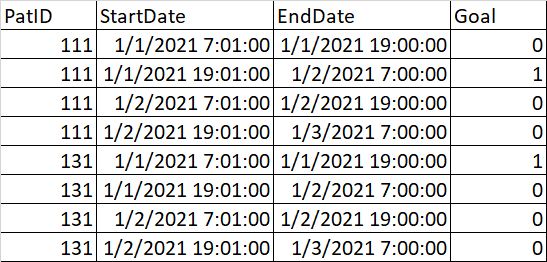Both values between Start and End date
-
good afternoon,
I'm trying to determine if both values (101 and 102) both occur within a 'Shift' (startdate/enddate). It originally just needed 101, but our facility added 102 and for the 'goal' to be compliant (1), they need to be both present within a shift. I'm having a bit of trouble working this out within my outer apply. The SQL Code below produces the correct output with just the value of 101. Below in the table is what I'd like it to output with both 101 and 102. Thank you in advance.
DROP TABLE if exists #values
DROP TABLE if exists #Risk
create table #values
(
PatID varchar(10)
,StartDate datetime2
,EndDate datetime2
)
create table #Risk
(
PatID varchar(10)
,ValueDate Datetime2
,Value int
)
Insert into #values
values
('111','2021-01-01 07:01:00.000', '2021-01-01 19:00:00.000')
,('111','2021-01-01 19:01:00.000', '2021-01-02 07:00:00.000')
,('111','2021-01-02 07:01:00.000', '2021-01-02 19:00:00.000')
,('111','2021-01-02 19:01:00.000', '2021-01-03 07:00:00.000')
,('131','2021-01-01 07:01:00.000', '2021-01-01 19:00:00.000')
,('131','2021-01-01 19:01:00.000', '2021-01-02 07:00:00.000')
,('131','2021-01-02 07:01:00.000', '2021-01-02 19:00:00.000')
,('131','2021-01-02 19:01:00.000', '2021-01-03 07:00:00.000')
Insert into #Risk
values
('111', '2021-01-01 08:01:00.000', 101)
,('111', '2021-01-01 19:05:00.000', 101)
,('111', '2021-01-01 23:07:00.000', 102)
,('131', '2021-01-01 07:01:00.000', 101)
,('131', '2021-01-01 07:06:00.000', 102)
,('131', '2021-01-02 10:01:00.000', 102)
Select
p.PatID
,p.StartDate
,p.EndDate
,case when a.PATID is not null then 1 else 0 end as 'Goal'
from #values p
OUTER APPLY (Select Top 1 r.PatID, r.ValueDate
from #risk r
where r.PatID=p.PatID and r.Value = 101
and (r.ValueDate >= p.StartDate and r.ValueDate <= p.EndDate)
Order by r.ValueDate) a
-
I wasn't 100% sure if 101 and 102 could appear more than once in the risk table, so I coded it to allow that, just in case.
If each can appear only once, then you can get away with using "having count(*) = 2" rather than two separate case conditions.
Select
p.PatID
,p.StartDate
,p.EndDate
,case when a.PATID is not null then 1 else 0 end as 'Goal'
from #values p
OUTER APPLY (Select r.PatID
from #risk r
where r.PatID=p.PatID and r.Value in (101, 102)
and (r.ValueDate >= p.StartDate and r.ValueDate <= p.EndDate)
group by r.PatID
having max(case when r.Value = 101 then 1 else 0 end) = 1
and max(case when r.Value = 102 then 1 else 0 end) = 1
) a
order by p.PatID, p.StartDateSQL DBA,SQL Server MVP(07, 08, 09) "It's a dog-eat-dog world, and I'm wearing Milk-Bone underwear." "Norm", on "Cheers". Also from "Cheers", from "Carla": "You need to know 3 things about Tortelli men: Tortelli men draw women like flies; Tortelli men treat women like flies; Tortelli men's brains are in their flies".
Viewing 2 posts - 1 through 1 (of 1 total)
You must be logged in to reply to this topic. Login to reply
